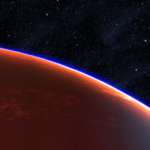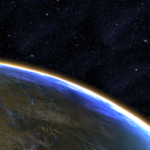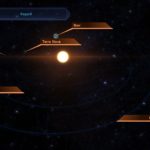System Specs:
- Stellar Mass: 1 Sol Masses
- Stellar Class: G2V
- Luminosity: N/A Sol
- Planets: 4
- Moons: 90
- Asteroid Belts: 0
- Asteroids: 1
- Objects: 0
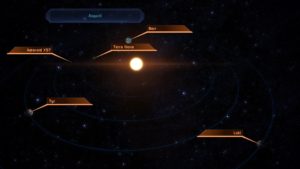
–
Planets Directory:
- Terra Nova
- Asteroid X57
- Borr
- Tyr
- Loki
–
Terra Nova:

- Orbital Distance: 1.3 AU
- Orbital Period: 1.5 Earth-years
- Keplerian Ratio: 0.976
- Radius: 5,261 km
- Day Length: 37.3 Earth-hours
- Atmospheric Pressure: 0.91 atm
- Surface Temp: 56 °C
- Surface Gravity: 0.95 g
- Mass: 0.642 Earth-masses
- Colony: human
Capital: Scott, founded 2152, population 4,400,000 (2183), 4,150,000 (2186)
Terra Nova was one of the Class-1 colonization prospects discovered by the first wave of Alliance surveys in 2150. It was the second human extrasolar colony, and the first beyond the Charon Mass Relay. It currently has the highest population of any Alliance colony.
Though banded by a harsh equatorial desert, areas closer to the poles are temperate. The pace of development was modest until extensive deposits of platinum were discovered in the 2170s. This rare metal, required in the clean-burning hydrogen fuel cells that power private vehicles, attracted a “platinum rush” of immigrants and investment from throughout Alliance space. In the past twelve years, Terra Nova has seen a 30% rise in population, and growth does not appear to be slowing.
Mass Effect 3
Terra Nova was one of the Class-1 colonization prospects discovered by the first wave of Alliance surveys in 2150. It was the second human extrasolar colony, and the first beyond the Charon mass relay. It once boasted the highest population of any formally endorsed Alliance colony, but in recent years threats of batarian attack caused many to emigrate. The name “Exodus Cluster” became all too apt.
The Reapers landed on Terra Nova after a brief battle with the Alliance’s Sixth Fleet. Aware that it would lose, the fleet retreated in hopes of meeting with allies and retaking the planet. Intelligence indicates that the Reaper force here is light, and debate rages over whether to try to liberate the planet, or if such an effort would prove futile if the Reapers sent reinforcements.
Assignments
Terra Nova from Asteroid X57
Assignment: X57: Bring Down the Sky
Assignment: X57: Missing Engineers
Assignment: X57: Avoid the Blasting Caps
Search and Rescue
Main article: Search and Rescue
Alliance Cruiser Shanghai
Properties
Terra Nova has no natural satellites; X57 is planned as an artificial one.
Given the orbits of planets Loki and Tyr, the sun Asgard ought to be a twin to Sol and Terra Nova would be about 1.3 AU from it. If Earth were at 1.3 AU from its sun, by the inverse square law it would get 59% of its heat.
Borr at six times Jupiter’s mass orbits at 1.7 times Terra Nova’s orbit; but since this would be 2.21 AU, even at its closest Borr does not provide enough radiation or raise enough tides to heat Terra Nova anymore. Earlier in the system’s history its effects would have been more extreme.
Terra Nova’s equatorial desert must have a Bond albedo comparable to that of a water ocean or lower (0.035); further, its atmosphere must hold a high proportion of greenhouse gasses other than water.
Terra Nova is a very dark, basaltic planet with few reflective clouds and high proportions of methane and carbon dioxide in its atmosphere. As the desert’s edge greens, the planet’s albedo will rise, and its temperature will fall accordingly.
Trivia
Terra Nova means ‘New Earth’ in Latin. Of the four planets in the Asgard system, it is the only one not named after a Norse god.
The capital, Scott, is likely named after the Arctic explorer Robert Falcon Scott, who commanded the doomed Terra Nova Expedition of 1910.
Terra Nova is also the name of one of the first human colonies in Star Trek. The colony was struck by a radioactive asteroid, which mutated the inhabitants of the colony, and contact was lost with the colony around 2081. The colony was rediscovered, along with the effects of the asteroid impact, by the Enterprise in 2151. Also noted is the captain of the Enterprise, played by Scott Bakula, who shares the same name as the colony’s capital city.
The similarities between Terra Nova of the Mass Effect Universe and the Terra Nova of the Heavy Gear Universe by Dream Pod 9, indicate a possible reference or homage. Both Terra Novas have an equatorial desert, and names of planets/systems nearby echo names of systems/planets in the Heavy Gear universe. Additionally, the events of the second Heavy Gear video game involve stopping a plot to hurl an asteroid at Terra Nova.
According to Mass Effect: Incursion, and contrary to the codex entry that states “growth does not appear to be slowing,” the population of Terra Nova has actually decreased since the events of Mass Effect, from 4.4 million to 4,145,412 humans.
When selected in the galaxy map, above the description there is exactly the same image which Earth has [1].
–
Asteroid X-57:
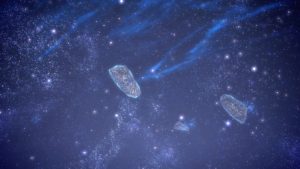
Before DLC Completion
X57 is a metallic asteroid, originally located at the trailing Lagrange point of the gas giant Borr. With the increased development on Terra Nova, a new orbital port facility was necessary. Due to a shortage of funding, it was decided to ‘mine out’ X57, using the recovered resources to finish out the interior for habitation. The asteroid was decelerated from Borr’s orbit using fusion torches, allowing it to fall into the orbit of Terra Nova.
Recently, communications with the engineering team on X57 have been lost. The fusion torches have reignited, and the asteroid is accelerating towards Terra Nova.
After DLC Completion
Asteroid X57 has been brought under control. Once repairs are complete, the asteroid will be carefully maneuvered into geosynchronous orbit around Terra Nova. Though the batarian terrorists have destroyed several months of work, experts predict it can still open for business before the end of 2184.
–
Borr:

- Orbital Distance: 2.2 AU
- Orbital Period: 3.3 Earth-years
- Keplerian Ratio: 0.978
- Radius: 74,612 km
- Day Length: 8.8 Earth-hours
- Atmospheric Pressure: N/A atm
- Surface Temp: N/A °C
- Surface Gravity: N/A g
- Mass: N/A Earth-masses
- Satellites: > 90
Borr is a huge hydrogen-helium gas giant with over 90 moons. Its striking coloration is caused by the light of ionized hydrogen filtering through an upper cloud deck of sodium. The source of the ionization has not yet been confirmed, but Borr’s mass (equal to six Jupiters) and high temperature suggest it may be a small “brown dwarf”, a large gas giant that gained nearly enough mass to ignite into a small star.
Through Borr’s deep gravity well makes mining operations difficult, it is the only gas giant in the system. The hydrogen needed for the local fuel cell industry, combined with the ever-present need for helium-3 fusion torch fuel, make it economical to mine.
Mass Effect 3
Borr is a hydrogen-helium gas giant with over 90 moons. The light of ionized hydrogen filtering through an upper cloud deck of sodium causes its striking coloration. The source of the ionization has not yet been confirmed, but Borr’s mass (equal to six Jupiters) and high temperature suggest it may be a “brown dwarf,” a gas giant that gained almost enough mass to ignite into a small star.
The Reapers destroyed Borr’s extensive helium-3 infrastructure, although wreckage indicates that the Sixth Fleet did not give up the planet without a fight.
–
Tyr:
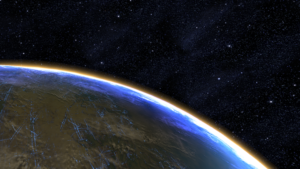
- Orbital Distance: 4.0 AU
- Orbital Period: 8.05 Earth-years
- Keplerian Ratio: 0.988
- Radius: 6,332 km
- Day Length: 46.2 Earth-hours
- Atmospheric Pressure: 0.8 atm
- Surface Temp: −73 °C
- Surface Gravity: 0.95 g
- Mass: 0.929 Earth-masses
- Colony: human
Capital: Kaldidalur, founded 2156, population 47,000 (2183), 44,000 (2186)
Tyr is compositionally quite similar to Earth. However, it lies over 4 AU from Asgard, and possesses an atmosphere primarily composed of nitrogen and ethane. While a potential target for terraforming, the presence of the ‘shirt sleeves’ habitable Terra Nova relegated Tyr to a support role.
Nearly a hundred corporations – human and alien – have constructed extensive teleoperated mining, refining, and manufacturing facilities across the face of Tyr. Combined with the platinum lodes of Terra Nova, the resources they produce are driving development of the local hydrogen fuel cell industries. The Asgard system now supplies nearly 4% of the galactic market.
Mass Effect 3
Tyr is compositionally similar to Earth. However, it lies over 4 AU from Asgard and possesses an atmosphere primarily composed of nitrogen and ethane. While a potential target for terraforming, the proximity of the “shirt-sleeves habitable” Terra Nova relegated Tyr to a support role.
Nearly one hundred corporations–human and alien–constructed tele-operated mining, refining, and manufacturing facilities across the planet. The Reapers immediately targeted these, seeking to cut off the Alliance’s supply of hydrogen fuel cells.
–
Loki:
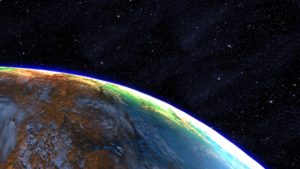
- Orbital Distance: 6.8 AU
- Orbital Period: 17.8 Earth-years
- Keplerian Ratio: 0.992
- Radius: 3,630 km
- Day Length: 61.3 Earth-hours
- Atmospheric Pressure: 0.2 atm
- Surface Temp: −135 °C
- Surface Gravity: 0.22 g
- Mass: 0.071 Earth-masses
Loki is a small terrestrial world with little to recommend it. One hemisphere is largely covered by an ice cap, and the other by craggy basaltic highlands. The rough, varied terrain suggests an ancient cataclysm caused significant damage to the planet. This is seemingly reinforced by its unusually elliptical orbit, which reaches 6.5 AU at perigee and 7.1 AU at apogee.
Penetrating scans of Loki’s ice cap reveal a network of crisscrossing subterranean tunnels. Because some of the tunnels were surprisingly regular in shape and size, early expeditions looked for signs of excavation. It was concluded they formed by natural processes.
Loki’s thin atmosphere is mostly composed of krypton and xenon. When it approaches perigee, frozen sulphur trioxides and dioxides can evaporate into clouds on the hemisphere facing Asgard.
Mass Effect 3
A small terrestrial world with little to recommend it, Loki’s one hemisphere is largely covered by ice, and the other by craggy, basaltic highlands. The rough, varied terrain suggests an ancient cataclysm caused significant damage to the planet. Reaching 6.5 AU at perigee and 7.1 AU at apogee, Loki’s unusual elliptical orbit reinforces this hypothesis.
Beneath Loki’s ice cap runs a naturally formed network of subterranean tunnels. These may have proven useful to Alliance forces in retreat. Nevertheless, any organics hidden here remain in peril, as Loki’s atmosphere is inhospitable and Reaper scanning technology is efficient.
–
–
video



